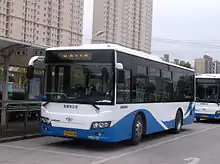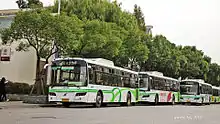Buses in Shanghai
Shanghai has more than 1000 formal bus lines (including city center and suburban lines), served by more than 10 bus companies. In the past, Bashi, Dazhong, Guanzhong and Qiangsheng were the four largest; around 2009 they merged to become Bashi Group Companies, including Bashi No.1-6 Bus Passenger Service Companies, Bashi Tram, Bashi Xinxin and Chongming Company, Baoshan Company and Jinshan Company. Each Suburban district also renewed with one company serving each district. Around 2015, Bashi No.1 Passenger Service and Bashi Tram merged to be Bashi No.1 Company, Bashi No.2 Passenger Service became Bashi No.2 Company, Bashi No.3, No.4 Passenger Service merged to be Bashi No.3 Company, Bashi No.6 Passenger Service became Bashi No.4 Company, and Bashi No.5 Passenger Service and Baoshan Company became Bashi No.5 Company.
.jpg.webp)
Liverys of different bus companies differ. The most ordinary livery is often called "SH Livery", which was established in 2001. Bashi Group buses, Jinshan Bus Co. of Jinshan District, Minhang Bus Co. of Minhang District and other private bus companies use such kind of livery, while different in colors. Pudong Bus of Pudong New Area has its special livery established in 2009, which is blue and is often called "Haibao Livery". Songjiang Bus of Songjiang District has a livery of a combination of red and grey, which was established in 2007. Fengxian Bus of Fengxian District has a livery of green and white and another livery based on "SH Livery" but with the color of green and blue, which were established after Fengxian Bashi and Fengxian Bus (local owned).Qingpu Bus of Qingpu District started using new livery since the end of 2015, which contains the same color with Bashi "SH Livery" but has different patterns. Zongshen Dazhong of Qingpu District has a special livery of a combination of yellow and green on some of its bus routes.
The Shanghai bus fleet has become increasing green in recent years. As of May 2015, the system has over 1,700 new energy buses, amounting to over 20% of the entire fleet.
Since 2006, Shanghai has been the leading Chinese system to implement electric and hybrid buses. During the 2010 Shanghai World Expo, the city piloted a program that includes 256 new energy buses with low to no emission. Some routes are operated by the Shanghai trolleybus system, and although the number of such routes is relatively very small compared to the overall Shanghai transit network, the trolleybus system carries the distinction of being the oldest existing such system in the world[1] (of more than 300 such systems still in operation in 2011); it opened on 15 November 1914.[1]
During the mid-2000s, the city converted many traditional trolley routes to a standard diesel fleet because of route flexibility, speed, and eliminating the visual pollution of overhead wires. However, the obvious benefits of the trolley buses have brought back a renewed interest in keeping and developing the program. In 2013, Bashi Trolley Bus Company ordered 300 new trolleybuses to replace the aging fleet and grow the overall number of trolleys in Shanghai.


Naming scheme

Most downtown buses use numbers to specify the lines, while suburban buses and a few downtown bus lines use Chinese characters. In the recent decade, there has been increased activity in network optimization and as a result, many bus lines have been cut, shorted, and combined. Many named bus lines have been converted to number lines with a flat fare. Some regular lines have been changed to rush-hour only, while still keeping their original line numbers.
Numerical lines
- Line numbers under 200 are conventional buses (Chinese: 常规公交线路). In these buses, lines under 30 (except 11, 17, 18, 21, and those starting with 0), as well as 71 are trolleybuses. All trolleybuses are air-conditioned.
- Line numbers between 200 and 299 are mostly lines dedicated for rush-hour only, with some exceptions where those numbers are used for conventional buses. For example, 218 runs from Yindu road/Laohumin road to Lujiabang Road. It’s one of the exceptions that are conventional buses.
- Line numbers between 300 and 399 are night buses (Chinese: 夜宵公交线路).
- Line numbers between 400 and 499 are buses that cross the Huangpu River. There are also many other bus lines that cross the Huangpu River.
- Line numbers between 500 and 599 are special-line connecting buses (Chinese: 专线公交线路).Some of them are merged into one line(e.g. Bus line 562 & 62 merged into 62), and some lines are renamed using the numbers between 900 and 999 after its buses were replaced by air-conditioned buses during 1990s(e.g. Former Bus line 591 renamed into 936).
- Line numbers between 600 and 699 are special-line buses in Pudong.
- Line numbers between 700 and 799 are suburban conventional lines (Chinese: 通郊公交线路).[2] Most 700s buses have at least one terminal beyond Outer Ring Road (S20 Road).
- Line numbers between 800 and 899 are special-line buses (Chinese: 专线公交线路). Most of them are mid-size buses, but now they are being replaced with air-conditioned large buses. These lines were previously run by private companies, but have since been overtaken by some big bus groups, The quality and reliability of these lines have been improved significantly.
- Line numbers between 900 and 999 are air-conditioned special-line buses (Chinese: 空调专线公交线路). All of them are full-size and air-conditioned.
- Line numbers over 1000 are community conventional buses (Chinese: 社区短驳公交线路). These usually use medium-size buses to connect neighborhoods to bus or subway stations and have circular routes.
Non-numerical lines
- Tunnel Lines (Chinese: 隧道公共汽车线路)
Tunnel Lines 1 to 9, except Tunnel Line 5, run across a tunnel under Huangpu River. While being the same as buses in the 400s, there are many other buses that cross the many tunnels under the Huangpu River while not named as a tunnel line.
- Bridge Lines (Chinese: 大桥公共汽车线路)
Bridge Lines 1 to 6 run across bridges over the Huangpu River, including Lupu Bridge, Nanpu Bridge, and Yangpu Bridge. While being the same as buses in the 400s, there are many other buses that cross the many bridges over the Huangpu River while not named as a bridge line.
- Airport Lines (Chinese: 机场公共汽车线路)
Airport Lines 1 to 7 connect Pudong International Airport to downtown Shanghai and Hongqiao International Airport, while Airport Special Line (Chinese: 机场专线) connects Hongqiao International Airport to the Jing'an Temple in downtown Shanghai.
- Sub-urban and Rural Lines (Chinese: 郊区公共汽车线路)
There will be various additional naming schemes in the alphabet lines. Most lines are named as "XY Line", where X and Y indicate the two terminals of this line, e.g., "莘纪线" (Xin Ji Line) is a bus which runs between Xinzhuang and Jiwang.
Some other lines only indicate one terminal, e.g., "宝杨码头专线" (Baoyang Port Special Line) is a bus which runs between Baoyang Port and Shanghai Railway Station.
In the central portion of some suburbs, there are lines with the name format of "XX No. X" line.
- Some of them are community conventional buses (Chinese: 社区短驳公交线路 whose names are started with the name of a town, sub-district, or, directly, district, e.g. Jiangchuan Route 1 (Chinese: 江川1路) in Minhang and Jiading Route 103 (former Anting Route 1) Chinese: 嘉定103路(安亭1路).
- Some of them are special-line buses (Chinese: 专线公交线路) for special events, e.g. Expo Route 18 (Chinese: 世博18路),
- Some of them are special-line buses (Chinese: 专线公交线路) for Terminal Stations, e.g. Hongqiao Hub Route 5 (Chinese: 虹桥枢纽5路), Temporary Special Route 1 and Route 4 for Chunyun (Chinese: 春运临时专线1路、4路, now named Route 01 and 04) for West Shanghai Railway Station.
Fare
- Shanghai in principle follows the convention which prevails in most Chinese cities whereby 'standard' buses charge between 1 - 1.8 元 (yuan, usually referred to as 'kuai') while air-conditioned buses (identifiable by a 'K' prefix) charge 2 yuan. This is generally irrelevant today, however, as all buses in Shanghai are air-conditioned and thus 2 元. The fare for children is 1 yuan.
- Other line numbers under 400, those between 700 and 799, tunnel lines, and bridge lines are ordinary buses and charge 1 yuan (not more than 13 km) or 1.5 (over 13 km), and if air-conditioned, the fare is 2 yuan.
- Three-digit line numbers starting with 5, 6, 8, and 9 use distance-based fares starting from 1 yuan (exceptions exist, such as the 947 line running from Zhongshan Park subway station and the 876 running from Songhong Road subway station, both of which are flat-fare air-conditioned buses).
- Some use a flat-rate fare (Chinese: 单一票价), while some use distance-based fares. If a bus has a conductor then the fare is distance-based (with a few exceptions), otherwise it will be flat-fare.
Shanghai Public Transport Card
All flat-rate fare and numbered lines and most distance-based fare lines accept the Shanghai Public Transport Card.
Trams in Shanghai
The first public transportation tram line in Shanghai was from the Jing'an Temple to Bund, but this line has now disappeared as service was canceled (however, the route itself lives on as part of trolleybus route 20). Now, only one tram line is running in Shanghai Movie Park for tourists.
In 2007, the Shanghai government decide to proceed with construction of a new modern tram in Zhangjiang Hi-Tech District, named "Zhangjiang Tram". It opened for passengers on December 31, 2009.
A new tram system in Songjiang District is now under construction and the first lines will be open in no earlier than 2016.

